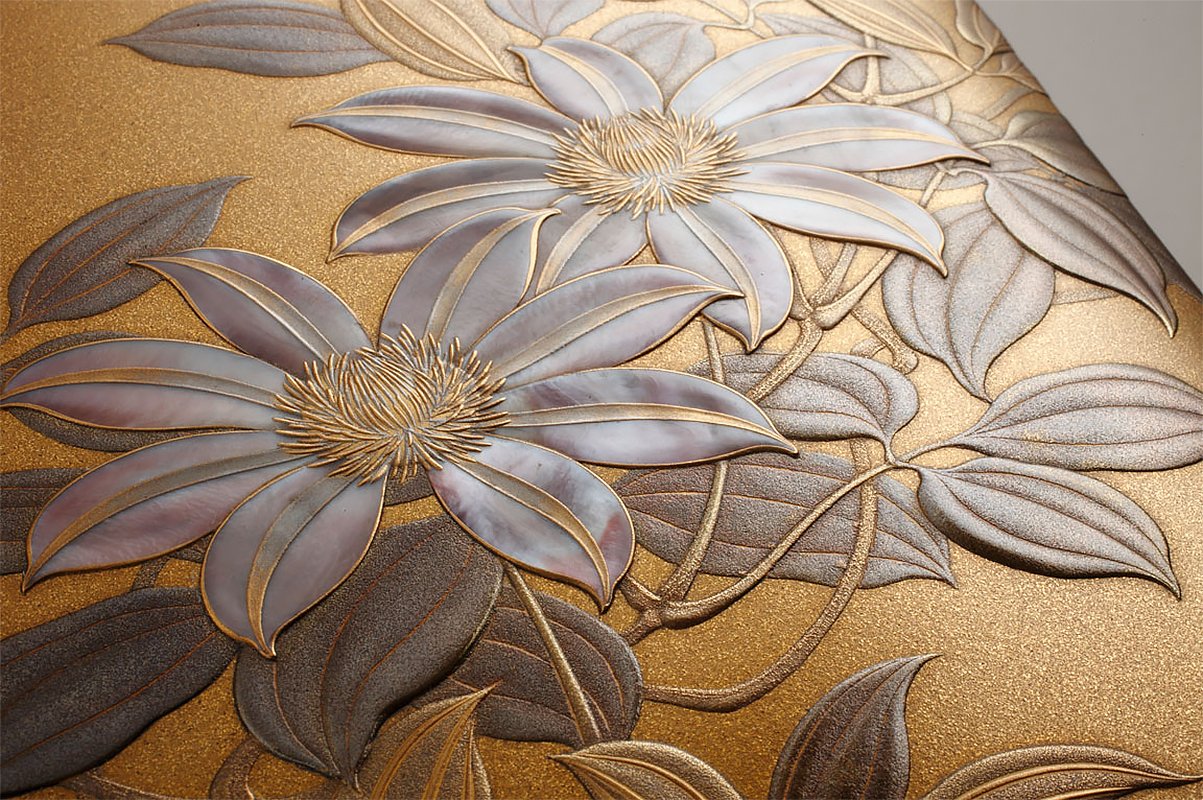MEIJI-TAISHO
AKATSUKA JITOKU, IMPERIAL PRESENTATION LACQUER CLEMATIS TEBAKO
Tebako or ornamental cosmetic box in a rectangular form with softly rounded edges, decorated in relief with the Imperial chrysanthemum crest and flowering clematis against a very finely textured gold ground. Of gold lacquer decorated in gold and colored taka-maki-e or raised lacquers, the interior and base executed in very fine nashiji or gold flake and gold dust lacquers, and sculpted aogai or inlaid mother-of-pearl. With applied silver mounts. Attributed to Akatsuka Jitoku (1871 – 1936). Late Meiji era, circa 1900 – 1910.
With the original, period, red-lacquered storage box, with an applied paper label on the exterior of the lid inscribed with the date memorializing the gift of the lacquer to an Imperial prince on May 25th, 1910; the reverse of the lid with the letter from the Imperial Household Agency recording the gift of the lacquer to Kitashirakawa no Miya or Prince Kitashirakawa.
Prince Kitashirakawa Naruhisa (1887 – 1923) was the head of the 5th oldest branch of the Imperial Family, formed from the branches of the Fushimi-no-miya house. On April 29th, 1909 he married the 7th daughter of the Meiji Emperor, Fusako, Princess Kane (1890 – 1974). He died in Paris from an automobile accident on April 1st, 1923.
Akatsuka Jitoku was one of the most famous lacquer artists working during the late Meiji and Taisho eras. A member of the Teikoku Geijutsu-in or Imperial Art Academy, he often worked on commission from the Imperial Household Agency to create presentation lacquers decorated with the Imperial mon or crest. Jitoku’s style classically incorporated extremely fine inlaid shell-work, the best of which shows very delicate shading of the mother-of-pearl and three-dimensional sculpting rather than merely flat inlays. As well, his lacquers commissioned by the Imperial Household Agency famously incorporate scrolling floral motifs on presentation boxes. Jitoku’s aesthetic influenced many other lacquer artists of the late Meiji and Taisho eras, with its diagonal play of natural foliage balancing large negative space both on the top and sides of box. His elegance of style describes the best Taisho lacquers and forms a lasting influence on Japanese lacquer art.
Not all Imperial commissions were created equal and this clematis box reflects the best of Jitoku’s artistry. Gifts destined for individuals of princely rank demanded the finest work from their creators. The delicately-shaded shell inlays, painterly in their glowing lavender and white tones, ripple and shift in the light. Thousands of shells would be sorted to find the right coloration and quality for one box. Then, Jitoku carved each petal to different effect, some beveled, some rounded, some stippled from the reverse. So against a quiet, matte-gold ground, the clematis seem to wave freely under the sun of the Imperial crest. Likewise, his treatment of the darker and lighter foliage, the bright edging of the veins and stems in higher relief, and the amazingly realistic treatment of the soft yet crisply delineated stamens all raise the sense of contrasting movement between the floral motif and the reserved, conservative ground.
Akatsuka Jitoku, Imperial Presentation Lacquer Clematis Tebako
Artist Name: Akatsuka Jitoku
Period: Meiji Taisho
Mediums: Lacquer
Characteristics: Imperial
Form: Ornamental Boxes
Origin Country: Japan
5 3/8” high x 10 3/8” long x 8 ½” wide
This piece is no longer available.








